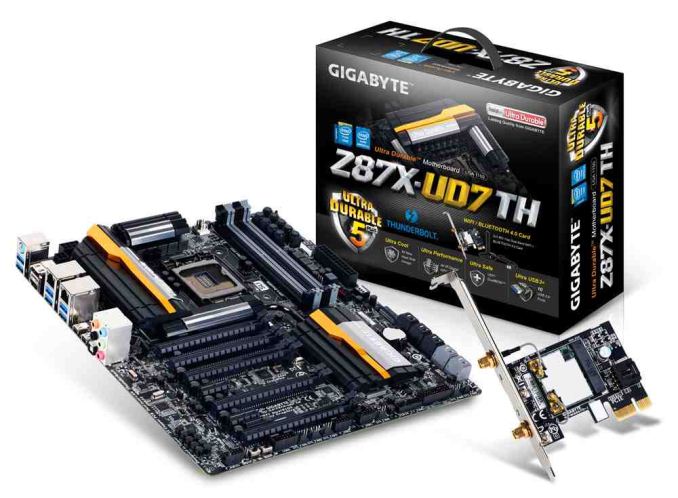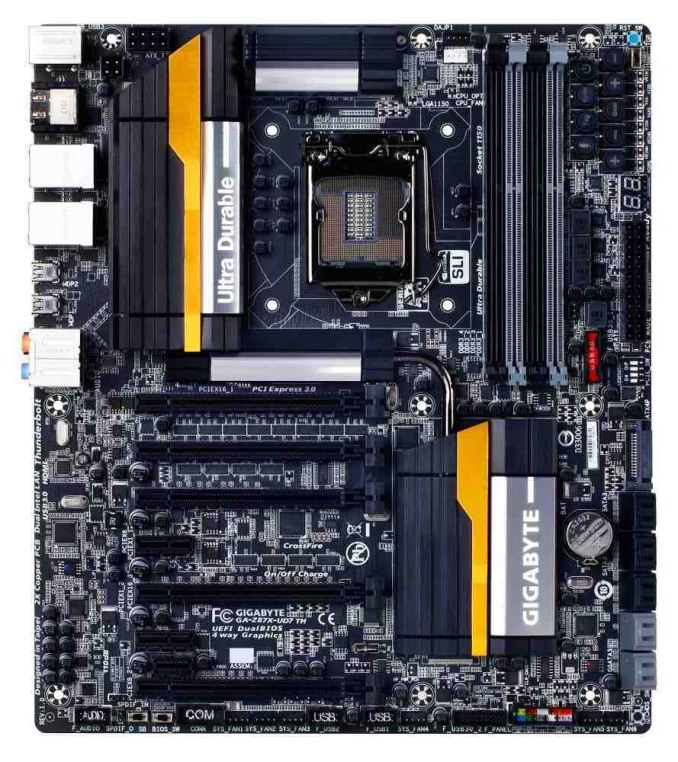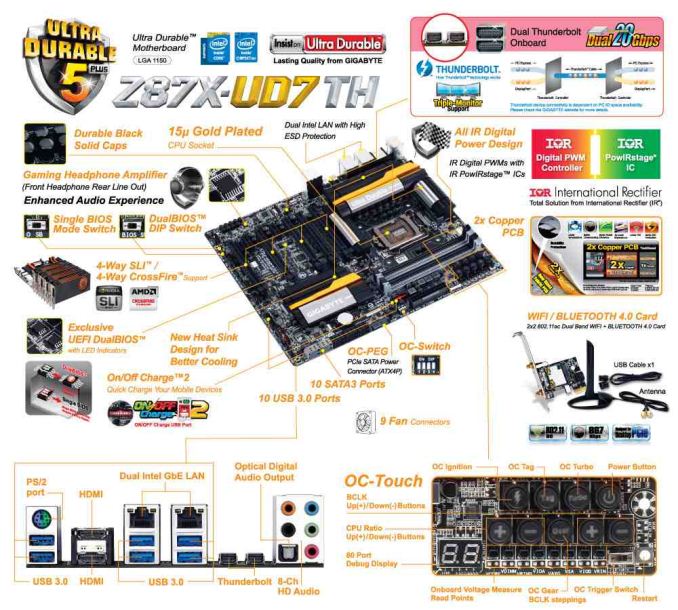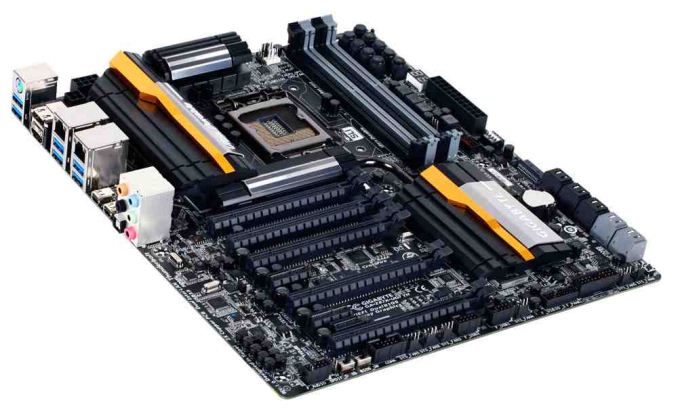Thunderbolt 2 certified on GIGABYTE Z87X-UD7 TH
by Ian Cutress on December 14, 2013 3:59 AM EST- Posted in
- Motherboards
- Intel
- Gigabyte
- Thunderbolt 2

The drive for faster and more efficient interfaces, particularly those over cables, is driven by a large number of consumer devices producing and displaying higher definition content. This only ever continues to grow, and thus the ecosystem around data transfer has to catch up – one prong of this voyage is that of the Intel Thunderbolt controller. Now in its second generation format, Thunderbolt 2 offers up to 20 Gbps of PCIe and DisplayPort data across the controller. The most famous device to be equipped with the controller comes from Apple in the new Mac Pro, however PC partners are also joining in the game. The sword today is being wielded by GIGABYTE, and their Z87X-UD7 TH motherboard.
We saw this motherboard back at Computex, still in its design phase and waiting for Intel to launch their TB2 controller to OEMs. The UD7 moniker on GIGABYTE motherboards is only for the high end channel segment of their lineup, and the specification list shows:
- Dual port Thunderbolt 2 (20 Gbps combined max throughput)
- PLX8747 chip for 4-way SLI and Crossfire, with PCIe x16 bypass
- Bundled 802.11ac WiFi PCIe x1 card
- Dual Intel Gigabit Ethernet
- Ultra Durable 5 Plus (60A IR3550 ICs and 60A chokes in the power delivery)
- OC Touch/OC Ignition buttons
- Nine fan headers
- Realtek ALC898 Audio + Sound Blaster X-Fi MB3 software + Headphone Amplifier
- Ten USB 3.0 ports, ten SATA 6 Gbps ports
- High gold content connectors to reduce resistance and increase longevity
- Dual HDMI video outputs
Putting this all into perspective and pricing: a TB2 controller costs around $40, a PLX chip is somewhere between $20-$40 depending on the deal, an 802.11ac module is found on $150 ITX motherboards so cannot be that expensive, IR3550 ICs and Chokes are ~$4 each which is expensive for power delivery, and features like OC Touch/OC Ignition have associated R&D costs of their own. This is alongside high gold content connectors, USB 3 and SATA 6 controllers, dual Intel NICs and support for nine fan headers.
What should be interesting is the PCIe layout of this motherboard: here we have a system using a PLX chip, promoting eight or sixteen PCIe lanes from the CPU to 32. The TB2 controller needs PCIe 2.0 x4, which could either come from the PLX 8747 chip or the chipset/PCH. Due to the wording on the Gigabyte website, it would seem that they come from the PCH, using switches such that when the Thunderbolt ports are used, some of the PCIe lanes are not available.
There is also something intriguing regarding FlexIO. FlexIO is the system that distributes PCIe 2.0 lanes from the chipset. Normally there are eighteen lanes available, four reserved for SATA 6 Gbps ports, four reserved for USB 3.0 ports and six reserved for normal PCIe x1. That leaves four left, split into pairs – the first pair can be configured as 2x USB 3.0 or 2x PCIe x1, and the second pair can be configured as 2x PCIe x1 or 2x SATA 6 Gbps, or a combination (one of each) therein, although the total must not be more than eight PCIe x1 lanes. In the specification sheet, GIGABYTE is only using two USB 3.0 ports from the PCH, choosing to add two Renesas uPD720210 USB 3.0 hubs. That means that two USB 3.0 ports (or the equivalent of two PCIe x1 lanes) are not being used, or GIGABYTE has found a way to fool the chipset into thinking they are USB ports when in fact they are something else. This is definitely worth delving into, but Occam’s Razor may apply: they might simply not be used.
GIGABYTE are aiming for the prosumer with this model: it differs from gamers (who have the G1 range) and overclockers (the Z87X-OC and Z87X-OC Force) and goes straight for a solid work system/workstation build alongside competition from other motherboard manufacturers.
Pricing and release date are as-yet unannounced, though I would not be surprised if we come nearer the $350-$400 mark by the end of the year.
Edit: The board is available today from Newegg for $430, which is around the OC Force pricing.















22 Comments
View All Comments
The Von Matrices - Saturday, December 14, 2013 - link
Whoops, I meant he said 6/8/4 PCIe/SATA/USB3 in the review whereas it actually should be 6/6/6.The_Assimilator - Saturday, December 14, 2013 - link
Yeah, this is getting embarrassing now. The motherboard manufacturers have figured out that they can get away with USB 3.0 hubs because there are still so few USB 3.0 devices in circulation, but I would expect Anandtech to call them out on this.And no ALC1150 on a board of this price? I guess corners had to be cut somewhere, but on the audio?
The Von Matrices - Saturday, December 14, 2013 - link
Part of the advantage of USB 3 hubs on Z87 is that it solves the C1 chipset errata of USB devices disappearing upon resume from sleep.IanCutress - Monday, December 16, 2013 - link
Apologies for not responding sooner, I have been at an overclocking meet all weekend and wrote this news on the train to the event.I did not see your previous message (always easiest to contract me via email to make sure I do) but for whatever reason I had not made the connection between standard port hubs and hubs via a chip on board until your post. Describing 'hubs are hubs' threw me off a little, but basically it's similar to a PLX switch for USB. This ultimately limits upstream throughput, but there are very few instances where multiple USB devices are requiring different upstream and downstream transfers such that a hub should not be an issue (even more if they are simply IO devices). I will note it in future.
A note about the block diagram: it does not show the USB hubs as clearly as they should (chipset -> USB port -> USB hub -> 4x USB ports), but rather chipset -> USB hub -> 4 USB ports, which is unclear in that regard. Before I posted this I did request the chipset diagram from my PR, which did not show exactly what you said and left bits out to make it easier to understand. After returning to it after your post, I can see what you are saying and agree with you, however it is not 100% clear unless that controller/hub distinction is clear in ones mind.
As always, I am very much open to discussion if you feel I've misinterpreted anything - reviewing is always a two way process and I always aim to give our readers the best possible detail. This one was just a matter of hub/controller differentiation not being fixed in my understanding. Drop me a line anytime:).
Ian
genzai - Monday, December 16, 2013 - link
Thanks Ian,I have very high standard for the site after years and years in your readership and so I don't like seeing errata. I agree that the diagram could be a bit clearer but that it would possibly seem a bit redundant to show a usb port branch before the hub as it is explicitly coming off the PCH and and explicitly not coming off the PCIe bus in the diagrams. So I think it is fairly clear. In any case keep up the good work and busy schedule, and if you find time feel free to correct the articles. I do agree that its a pretty smart move to use hubs onboard to increase USB port counts given the limitations of FlexIO and that for most uses the aggregate bandwidth issues of the hub won't be a problem. The I/O as such is better utilized on PCIe lanes and SATA ports. In the unlikely event I find corrections in the future I will email them to you instead of posting here.
Thanks,
g\
MadAd - Saturday, December 14, 2013 - link
$430!!!!!!!!!The_Assimilator - Saturday, December 14, 2013 - link
Motherboard manufacturers need to get their s**t together regarding USB 3.0 headers. Just bloody well group 'em together at the bottom of the board like the USB 2.0 headers! Move some of those fan headers and the useless COM header if you have to, just get this sorted out!The Von Matrices - Saturday, December 14, 2013 - link
I'm not a big fan of USB 3 headers being on the bottom of the board. You can't use them when double width PCIe cards are in the bottom most slot. I prefer them to be on the right edge.skyntax.256 - Saturday, December 14, 2013 - link
this motherboard is Cerberus colored. Very cool.DV8_MKD - Monday, December 16, 2013 - link
All these comments and not one about TB 2. Talk about the new firewire...